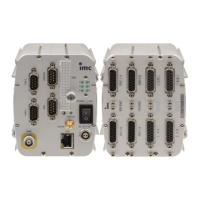© 2018 imc Test & Measurement GmbH
imc C-SERIES - Manual, Version 4 R 3 - 2018-10-19
44 Properties of the imc C-SERIES
The derivative quantities displacement and angle measurement have the following settings:
·
Choice of one-signal and two-signal encoder
·
Start of measurement with or without "Zero impulse"
·
Number of pulses (per unit)
The input ranges and resolutions for the RPM or velocity also depend on the number of encoder
pulses set. If the number of pulses is known, the RPM and velocity values can easily be computed
using the above table according to:
RPM:
Input range = ([Frequency input range in Hz] * 60 / [Encoder pulses per revolution]) in RPM
Resolution = ([Frequency resolution in Hz] * 60 / [Encoder pulses per revolution]) in RPM
Behavior in response to missing signal pulses
If a sequence of signal pulses is slowing down and then one sampling interval elapses without any
pulse, no calculation can be performed for that sampling interval. In that case, the system assumes
that the rotation speed is simply decreasing and an attenuating signal course is extrapolated. This
"estimated" measurement value is then closer to the true value than the value determined from the
preceding sampling interval. This technique has demonstrated its validity in practice.
In extreme cases, the sensor does not return any more pulses, e.g. in case of a sudden outage. Then
the algorithm generates an attenuation curve, meaning values > 0, even if the measurement object
is actually no longer moving.
4.6.3.1.2 Measurement procedures
Differential measurement procedures
The quantities derived from event-counting, Events, Distance and Angle denoted by the annotation
(diff.) are "differential" measurements. The quantity measured is the respective change of
displacement or angle within the last sampling interval. (positive or, for dual track encoders, negative
also) or the newly occurred events (always positive).
If, for instance, the total displacement is desired, it must be calculated by integration of the
differential measurements using Online FAMOS functions.
Cumulative measurements
The quantities derived from event-counting, Distance and Angle appearing with the annotation (abs.)
are "cumulative" measurements. In cumulative measurements, the return value is the sum of all
displacement or angle changes, or of all event which occurred.
4.6.3.1.3 Scaling
A maximum value must be entered under Input range (max. frequency etc, depend on mode). This
Maximum determines the scaling factor of the computational processing and amounts to the range
which is represented by the available numerical format of 16bits. Depending on the measurement mode
(quantity to be measured), it is to be declared as an input range's unit or in terms of a corresponding
max. pulse rate.
In the interest of maximizing the measurement resolution it is recommended to set this value
accordingly.
46
46

